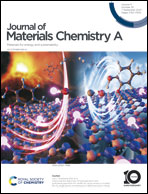Elucidating the lithium deposition behavior in open-porous copper micro-foam negative electrodes for zero-excess lithium metal batteries†
Abstract
In zero-excess lithium metal batteries (ZELMBs), also termed “anode-free” LMBs, Li from the positive electrode is electrodeposited onto a bare current collector instead of the Li metal negative electrode commonly used in LMBs. This enables high theoretical energy density and facile, safe, and low-cost assembly. To tackle coulombic inefficiencies during Li deposition/dissolution, 3D structured current collectors can be used instead of 2D foil materials. This study elucidates the Li deposition behavior in custom-made open-porous Cu micro-foams from nucleation to large scale deposition. For the first time in ZELMBs, surface and sub-surface Li deposits in open-porous 3D materials are compared to deposits on 2D foils using cryogenic focused ion beam scanning electron microscopy (cryo-FIB-SEM). The results highlight that Cu micro-foams can store substantial amounts of dendrite-free Li in their open-porous 3D structure, minimizing detrimental volume changes during Li deposition/dissolution. Electrochemical analyses and simulations reveal that current density distribution over the large surface area of the Cu micro-foams reduces the Li nucleation overvoltage by ≈40%. Also, charge/discharge cycling in ZELMBs shows increases in coulombic efficiency, capacity retention, and cycle life. Overall, this work explains how open-porous Cu micro-foam current collectors improve the Li deposition behavior to boost the cycling characteristics of ZELMBs.

- This article is part of the themed collection: Editor’s choice: Li-metal batteries


 Please wait while we load your content...
Please wait while we load your content...